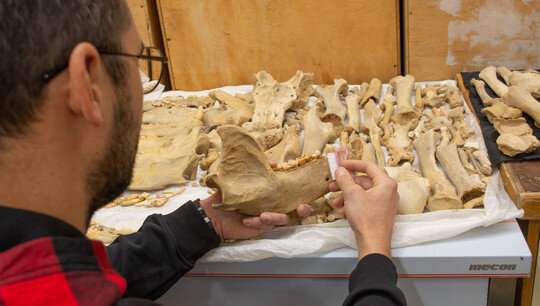Paleontologists find the jaws of an extremely rare bear in Taurida cave

Ural paleontologists discovered the lower jaws of an Etruscan bear from the Early Pleistocene (2–1.5 million years ago) in the Taurida Cave (Crimean Peninsula). Scientists reported the finding in the international journal of paleobiology Historical Biology.
Remains of Etruscan bears (which is the ancestor of brown and cave bears) as part of the fauna of large mammals of the Early Pleistocene were found in Western Europe, in Asia, as well as in North Africa, but not in Russia. The fact is that in Russia, Early Pleistocene faunas with remains of large terrestrial vertebrates were practically not known before. Crimea in this regard is an attractive and informative place for scientists.
“Our finding, on the one hand, extends the geography of the distribution of the Etruscan bear in Eastern Europe, and on the other hand, indicates that the ‘Crimean’ bear is a link between Asian and European counterparts. It also helps to characterize the evolutionary features within bears and the historical biogeography of this species,” says Dmitry Gimranov, senior researcher at the Laboratory of Natural Science Methods in Humanities at Ural Federal University and the Paleoecology Institute of Plant and Animal Ecology, Ural Branch of the Russian Academy of Sciences.
Archaeological digs were conducted by paleontologists in 2020-2021. The remains were found in the pre-surface layer of Taurida sediments, in a small chamber called “Hyena’s Den.” The research was conducted over the year. As a result it was found that the Etruscan bear coexisted next to such large predators as lynxes, giant hyenas, saber-toothed cats and wolves, with whom it had to compete for food resources just as it probably did with humans.
“More than 2 million years ago, together with the fauna of that time—antelopes, bulls, elephants, hyenas, Etruscan bears—ancient Homo man moved towards Eurasia. Generally, the presence of members of these faunas in the territories of Western Europe correlates with the presence of ancient Homo. We have not found the remains of ancient humans in Taurida, most likely they were there, we just have not found them yet. However, the structure of fauna of the cave Taurida—Etruscan bear, saber-toothed tigers, hyenas and other large mammals—suggests that at this time in this area could pass migration routes of ancient people,” says Dmitry Gimranov.
The Etruscan bear was a typical representative of European faunas during the early Homo period, scientists believe. The researchers drew their conclusion by comparing finds from the Taurida Cave and its closest point with the same fauna of the same age in Dmanisi, Georgia, where the earliest Eurasian Homo remains have been found.
Scientists from the Ural Federal University, the Institute of Plant and Animal Ecology, Ural Branch of the Russian Academy of Sciences, Paleontological Institute, Russian Academy of Sciences, and the Autonomous University of Barcelona took part in the study. In the next phase of work, paleontologists plan to study the food habits and ecological characteristics of Etruscan bears. This will help to understand how they competed for food resources with other large predators.
Ancient extinct cave bear DNA found in modern bears
Dmitry Gimranov et al, Ursus etruscus from the late Early Pleistocene of the Taurida сave (Crimean Peninsula), Historical Biology (2022). DOI: 10.1080/08912963.2022.2067993
Citation:
Paleontologists find the jaws of an extremely rare bear in Taurida cave (2022, May 20)
retrieved 20 May 2022
from https://phys.org/news/2022-05-paleontologists-jaws-extremely-rare-taurida.html
This document is subject to copyright. Apart from any fair dealing for the purpose of private study or research, no
part may be reproduced without the written permission. The content is provided for information purposes only.
For all the latest Science News Click Here
For the latest news and updates, follow us on Google News.

